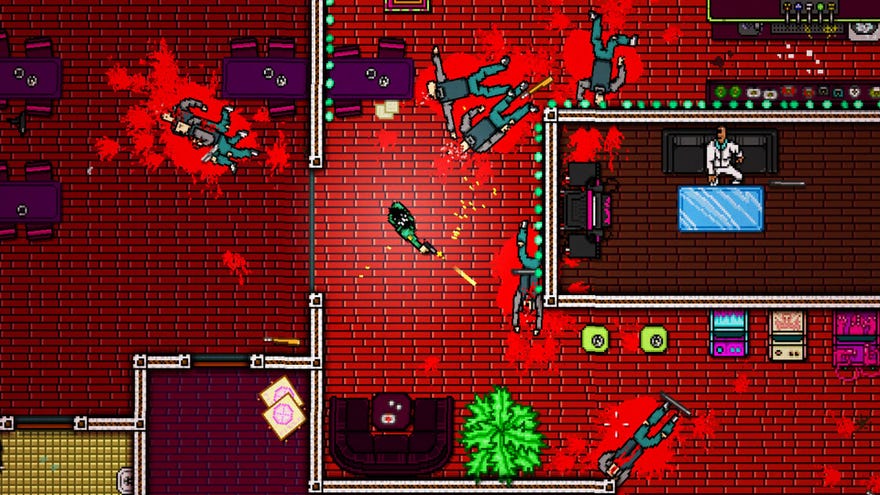What's better: Quick restarts, or a diegetic HUD?
Vote now!
Last time, you decided that improvised environmental weapons are better than skipping across a timeline flowchart. I can't say I'm too surprised, considering that timeline flowcharts are rare and that I did illustrate t'other with multiple screenshots of Kazuma Kiryu smashing men with bicycles. Now if Kiryu had been jumping between timelines... ah, we can't speculate, that's not scientific. This week, I ask you to choose between cutting something unnecessary and adding something unnecessary. What's better: quick restarts, or a diegetic HUD?
Quick restarts
Go. Die. Restart. Go. Die. Restart. Go. Die. Restart. Go. Die. Restart. Go. Triumph. Games like Hotline Miami and Super Meat Boy would not be the same if you had protracted death animations, loading screens, intro animations, and numerous mouse movements and button presses between attempts. Die. Restart. Go. Learn a level, develop a routine, and master it until you feel the level in your fingertips. Die. Restart. Go. Over and over, blank it out, sink in. Die. Restart. Go. Bliss.
In some games, you can pull a quick restart at will. This is hugely handy in time trial games like stunttastic car 'em up Trackmania. Clip a barrier after that loop-de-loop? Restart. Two seconds behind your best at the checkpoint? Restart. Just not feeling this wild air you've grabbed? Restart. If you had to finish the track before you could start over, you would be miserable. Even if you had to hit escape and go into menus, you'd be pulled out of it. Restart.
The surest way to know the importance of a quick restart is playing a game which doesn't have it but should. To restart a level in the excellent speedrunning shooter Neon White, you can press F to restart a level at any point, but it throws you back to a separate level start screen where you must then press spacebar to go. This only adds a splitsecond but that one extra key press and appearance of an extra screen makes so much difference. You can feel how wrong it is. You can feel how right a quick restart would be.
Diegetic HUD
While heads-up displays are so common in games that their presence is accepted as neutral, just part of the medium, I do like when games decide they need to justify this. You have a cybernetic eye. You have an AI riding in your brain. You're wearing high-tech sunglasses. Someone implanted a weird new organ. You're sitting in a mech cockpit lined with screens (and you can even see the seams if you look carefully). You're wearing an H.E.V. Mark IV protective system (for use in hazardous environment conditions). The point is, there are serious plot and world-building reasons why you can see your health and compass floating in the corners of your vision. I'm always here for developers making such a big show of justifying the presence of things I otherwise wouldn't question, which makes them seem: 1) more cool; 2) more fake; 3) but fake in a cool way.
These conceits also offer fun opportunities. At a critical point in Deus Ex: Human Revolution, for example, you don't have a HUD until you get cybereyes, and later The Man hacks your cyberparts and glitches out your digivision. Nice touch. More cyberpunk fooling comes in the delightfully strange E.Y.E.: Divine Cybermancy, where failing to hack a door might lead to it hacking you back and blocking your view with pop-ups until you hack yourself to clear the malware.
Nier: Automata goes the extra mile by mapping individual HUD elements like health bars, damage number pop-ups, the minimap, and more onto system chips plugged into your sad little robot's head. If you don't want those on your HUD, you can unplug them and handily clear more RAM space for other abilities and attacks. That's way more fun than an options menu. Just... don't unplug your OS chip. You need that one.
This being HUDs, not interfaces at large, let's not include fake computer interfaces like the desktop environment in Heretic's Fork or the EVA interface which wraps so far around Command & Conquer that it even covers the installer. Let's save those for later because they're good enough to celebrate separately. Same goes for mechanical interfaces like cockpits in flight simulators—though I suppose you can count the actual HUDs seen on simulated combat aircraft and such.
But which is better?
I'm torn. The quick restart feels so right. The diegetic HUD is so extravagant. I'll abstain from this one, so which do you think is better, reader dear?
Pick your winner, vote in the poll below, and make your case in the comments to convince others. We'll reconvene next week to see which thing stands triumphant—and continue the great contest.

